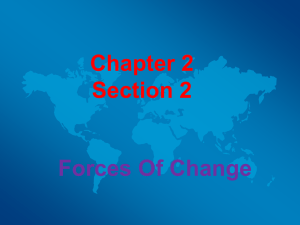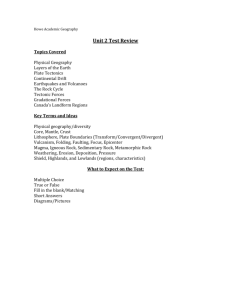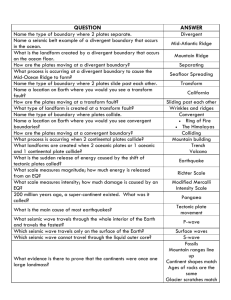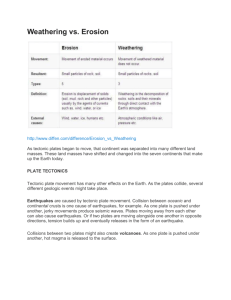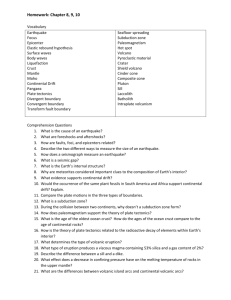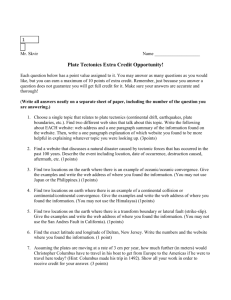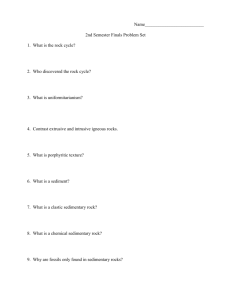Geolab Study Guide
advertisement
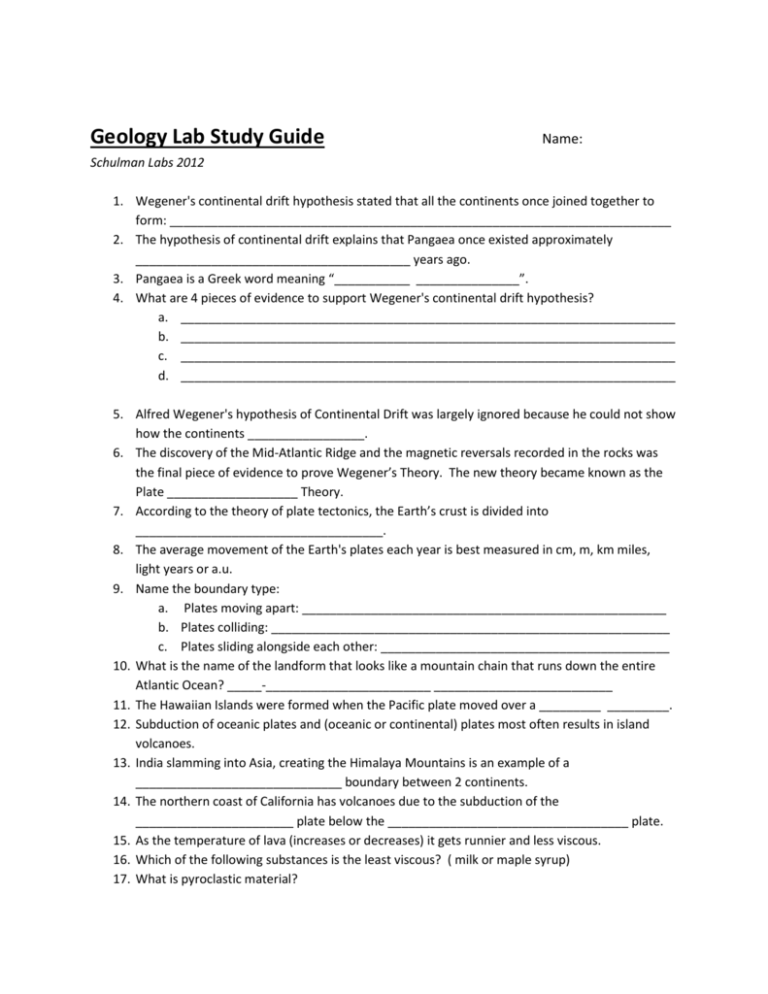
Geology Lab Study Guide Name: Schulman Labs 2012 1. Wegener's continental drift hypothesis stated that all the continents once joined together to form: _________________________________________________________________________ 2. The hypothesis of continental drift explains that Pangaea once existed approximately ________________________________________ years ago. 3. Pangaea is a Greek word meaning “___________ _______________”. 4. What are 4 pieces of evidence to support Wegener's continental drift hypothesis? a. ________________________________________________________________________ b. ________________________________________________________________________ c. ________________________________________________________________________ d. ________________________________________________________________________ 5. Alfred Wegener's hypothesis of Continental Drift was largely ignored because he could not show how the continents _________________. 6. The discovery of the Mid-Atlantic Ridge and the magnetic reversals recorded in the rocks was the final piece of evidence to prove Wegener’s Theory. The new theory became known as the Plate ___________________ Theory. 7. According to the theory of plate tectonics, the Earth’s crust is divided into ____________________________________. 8. The average movement of the Earth's plates each year is best measured in cm, m, km miles, light years or a.u. 9. Name the boundary type: a. Plates moving apart: _____________________________________________________ b. Plates colliding: __________________________________________________________ c. Plates sliding alongside each other: __________________________________________ 10. What is the name of the landform that looks like a mountain chain that runs down the entire Atlantic Ocean? _____-________________________ __________________________ 11. The Hawaiian Islands were formed when the Pacific plate moved over a _________ _________. 12. Subduction of oceanic plates and (oceanic or continental) plates most often results in island volcanoes. 13. India slamming into Asia, creating the Himalaya Mountains is an example of a ______________________________ boundary between 2 continents. 14. The northern coast of California has volcanoes due to the subduction of the _______________________ plate below the ___________________________________ plate. 15. As the temperature of lava (increases or decreases) it gets runnier and less viscous. 16. Which of the following substances is the least viscous? ( milk or maple syrup) 17. What is pyroclastic material? 18. What is a fault? 19. What is an earthquake's epicenter? 20. What is an earthquake's focus? 21. Most earthquakes are produced by the rapid release of ___________ energy stored in the rock that eventually snaps, much like a pencil. 22. Most earthquakes occur at or near ________________________. 23. Earth's thin, rocky outer layer is called its __________________. 24. A tsunami can occur when there is a vertical movement at a fault under ____________. 25. Violent shaking from an ___________________ can cause soil and rock damage on hillsides to fall and cause a landslide. 26. List 4 or more types of events caused by an earthquake: a. _________________________________________________ b. _________________________________________________ c. _________________________________________________ d. _________________________________________________ 27. The newest crust is found near _________________________________ boundaries. 28. The Ring of Fire is a chain of volcanoes surrounding the __________________________ Ocean. 29. The Hawaiian islands are created by a ____________ spot. 30. Earthquake vibrations are detected, measured and recorded by instruments called ___________________. 31. The Richter scale measures which earthquake characteristic? 32. During an earthquake, _____________-waves are a type of energy released that travel in an up and down, 'S' like motion. 33. During an earthquake, _______-waves are a type of energy released that travel out in a straight line from the focus.. 34. The study of earthquake waves is called ____________________________. 35. Sketch a normal fault. 36. Sketch a reverse fault. 37. Sketch a strike-slip fault. 38. Name that rock: a. This type of rock forms on the earth's surface at places such as beaches, rivers, and near the oceans. _____________________ b. This type of rock has a name which means "to change" and is formed inside the earth where there is much pressure.__________________________ c. This type of rock is formed by magma that is cooled and then becomes solid. ______________________________ 39. List Earth's layers in the order you would find them if you were drilling down from the surface. 40. Which of Earth's layers contains the densest materials? 41. According to the Law of Superposition, the layers of sediment on top are always _____________ than the layers of sediment below. 42. What does weathering cause? 43. List 3 or more examples of erosion? a. _________________________________________ b. _________________________________________ c. _________________________________________ 44. The process in which sediment layers build up over a long period of time is_________________________________. 45. A hurricane blowing down trees and moving sand, rocks and soil around is an example of___________________. 46. Humans cause erosion by __________________________________________. 47. Magma forms at divergent plate boundaries because the pressure on the rock deep below the surface near the mantle decreases. The decrease in pressure allows the hot rock to _________. 48. Which type of plate is denser oceanic or continental? ________________________. 49. Name that volcano type: a. Describes a volcano that is currently erupting or may erupt in the near future. ________________________. b. Describes a volcano that has not erupted in recorded history and probably never will. ________________________. c. Describes a volcano that is not erupting but records indicate it may erupt in the future. ________________________. 50. Florida has many white sand beaches. The sand grains on these beaches are made of the mineral quartz. The quartz grains came from the Appalachian Mountains and were transported to Florida by water currents. By what geological process were the quartz grains spread over Florida? ______________________________________________ 51. Weathering is a natural process that changes the Earth's surface. Animals like earthworms and other burrowing critters can also cause weathering. What kind of weathering do earthworms and burrowing animals cause? __________________________________________ 52. What is the cause of an earthquake? 53. What is thought to be the cause of tectonic plate movement? _____________________ 54. What is convection? 55. Why do large volcanic eruptions sometimes affect global climate? 56. Lava can flow as fast as 30 kilometers per hour. If lava is flowing from an eruption at that rate, how many kilometers will the lava travel in 30 minutes? ______________________



